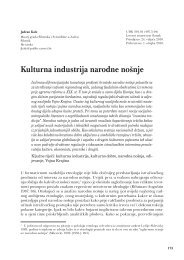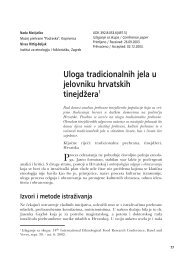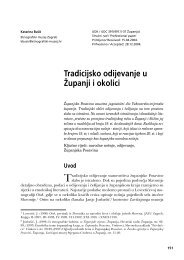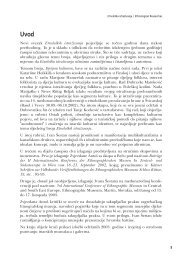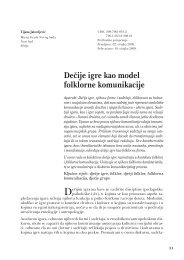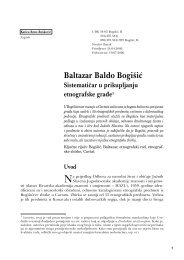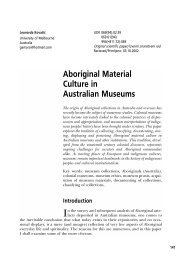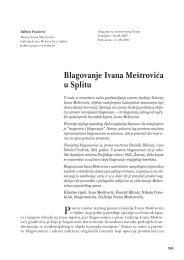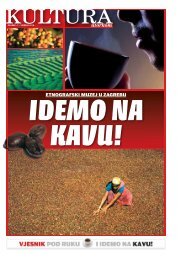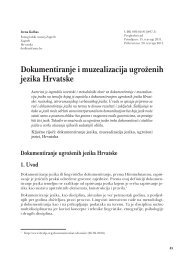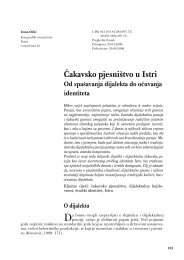Etnoloska istrazivanja / Ethnological researches - EMZ
Etnoloska istrazivanja / Ethnological researches - EMZ
Etnoloska istrazivanja / Ethnological researches - EMZ
You also want an ePaper? Increase the reach of your titles
YUMPU automatically turns print PDFs into web optimized ePapers that Google loves.
Etnološka istraživanja 15/<strong>Ethnological</strong> Researches 15<br />
Skok: treba – “pagan sacrifice”, Old-Russian trěba – “altar”, trebnik – “altar”, but i also<br />
can be “cleared land”.<br />
Silić: Proto-Slavic - *terbiti, Old-Slavic trěbiti: clear, Russian terebit’.<br />
e) Jurin konak – top (369 m) south-east from the top Gradine in Bosnia, about six<br />
kilometres away (Military topographic map 1:50 000, 1961).<br />
f) Crna kaljuga 9 – valley right under the top Jurin konak (The big atlas of Croatia<br />
to the scale 1:100 000, 2002).<br />
2. Toponyms that might be connected with mythical occupation of the area, but their<br />
meaning is too distant:<br />
a) Motajica<br />
Skok: mesti – Proto-Slavic motovilo, motouzica compound word < mot + uzica = motuz<br />
“rope”, Czech motouz, Slovak mot(v)oz, Polish motwąz, Russian motovjazъ. Also motka<br />
= switch.<br />
Silić: motati – wrap, turn, circle, twist – Proto-Slavic *motati (Russian motát´, Polish<br />
motać) ~ put, throw.<br />
b) Pratuš<br />
Skok: 1. prati – ie., Baltic-Slavic, Panslavic, Proto-Slavic *pьrati, perjo¸, > “hit, wash<br />
clothes”, “hit clothes with a piece of board to wash them” Ie. *per - “hit”. The one who<br />
hits, throws, beats the lightning – “washes” < Perun.<br />
c) Vlaknica<br />
Skok: vlakno - ie. *ŭolq-, Sanskrit valkám, valkás, Panslavic, Proto-Slavic *volkъno.<br />
Etymologically compatible with wool, blade, hair. The term vlakno is connected with<br />
cotton yarn and hemp spinning.<br />
vuna – ie. *wel- “pasture ground, meadow, the ground of the dead”.<br />
d) Kamenita glava – top (516 m)<br />
e) Kamenčić – top (213 m)<br />
The folk tradition from Kobaš, about taking the painting across the Sava to the top<br />
of the Bosnian mountain Motajica, and its miraculous return has been mentioned<br />
in the text for several times. The trail it left on the mountain and the sound of the<br />
bell on the place where it was crossing the river, together with the etymology of some<br />
in neighboring villages (Kuti, Kobaš) clear the grains and leguminous plants from the outer shell. As the<br />
old štokavian dialect contains some remains of the čakavian dialect (Ivšić, 1913; Pavičić, 2000), it is clear<br />
where completely the same name of the toponym Tribež comes from.<br />
9<br />
Possible comparison with the toponym Črne mlake near Ivanec which is in the same relation to the top<br />
Ivanščica (Belaj, 2007:427).<br />
306



